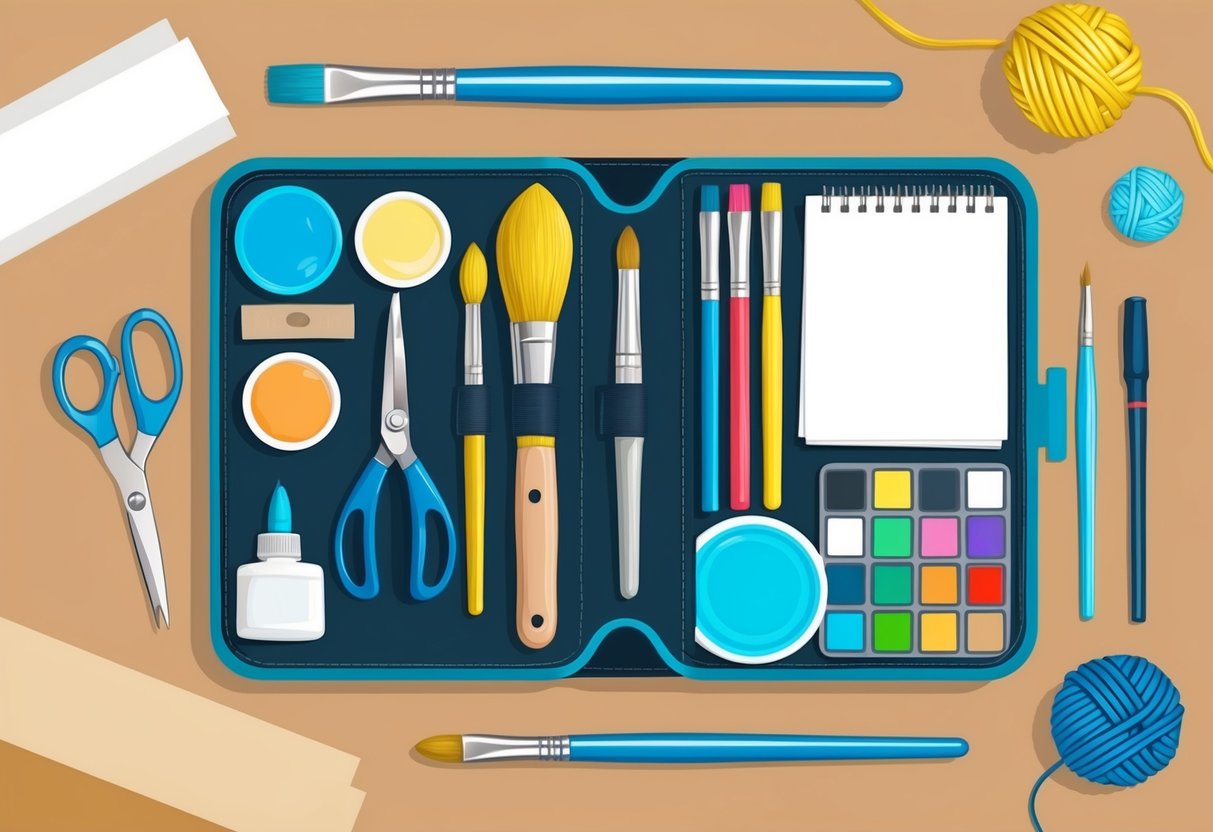
Starting a new hobby can feel overwhelming when faced with long lists of supplies. Having the right essential craft materials in your toolkit helps every beginner get off to a smooth start.
The must-have craft tools for beginners include sharp scissors, various adhesives, a craft knife, a cutting mat, and versatile papers—all of which make most creative projects easier and more enjoyable. These basics are recommended by both experienced hobbyists and guides, making them a solid investment for anyone exploring the world of DIY.
Alongside the core items like scissors and glue, many experts recommend specialty supplies tailored to different crafts, such as a rotary cutter for fabric projects or tweezers for intricate paper crafting. Tools such as pencils for marking, straight edges or rulers for precise measurements, and hot glue guns for secure bonds expand your capability and let creativity flow without interruption.
Beginners interested in advice from seasoned crafters can find additional suggestions for crafting success by exploring comprehensive craft supply lists and basic must-have craft tools.
Essential Cutting Tools for Beginners
Cutting tools play a crucial role in nearly every craft project. Selecting the right scissors for specific materials improves accuracy, safety, and ease of crafting.
Proper maintenance of these tools also helps ensure clean, precise cuts and a longer tool lifespan.
All-Purpose Scissors
All-purpose scissors are the backbone of any beginner’s toolkit. They can handle a wide variety of materials, from lightweight papers and cardstock to thin plastics and ribbons.
Durability and comfort matter when choosing quality scissors. Look for blades made from stainless steel, as these maintain sharpness longer and resist rust.
Comfortable, ergonomic handles make extended craft sessions easier and help prevent hand fatigue. Dedicated craft scissors should never double as kitchen or household shears.
Mixing uses could dull the blades or cause damage. Beginners benefit from keeping their all-purpose scissors separate, ensuring clean edges every time.
For more on essential cutting tools for general crafting, visit this guide on must-have paper crafting tools.
Fabric Scissors
Fabric scissors are essential for anyone working with textiles. Unlike general-use scissors, these feature long, sharp blades that make it easy to cut through multiple layers of fabric without snagging or fraying.
It’s important to keep fabric scissors reserved strictly for cutting fabric. Using them on paper or other materials can dull the blades quickly, leading to jagged cuts and wasted fabric.
Many crafters label these scissors or store them separately to avoid cross-contamination. A good pair of fabric scissors offers a straight, even cut every time, helping beginners develop clean sewing techniques and reduce wasted material.
Purchasing a sturdy, brand-name model is recommended for those who plan to pursue quilting, dressmaking, or other textile-focused crafts. For more advice on the importance of dedicated cutting tools for fabric, see this article on basic crafting tools.
Embroidery Scissors
Embroidery scissors are compact tools designed for precision tasks. Their slender, sharp tips allow crafters to snip threads close to fabric, cut intricate patterns, and make detailed adjustments to stitching.
Ideal for embroidery, cross-stitch, and other needlework, these scissors excel in areas where accuracy is critical. The small size makes them easy to control, minimizing the risk of accidental snags or extra-long thread tails.
Beginners should seek embroidery scissors with fine points and high-quality blades. Stainless steel is a preferred material for longevity and sharpness.
These specialty scissors can often be found with decorative handles, but sharpness and precision are the most important features for consistent results.
Staple Adhesives and Glues
Reliable adhesives are fundamental for a beginner’s craft toolkit. Different projects require specific types of glue for strong bonds, easy application, and clean finishes.
Versatile Glue for Crafts
A multipurpose liquid glue is one of the most essential items for crafting. Crafters often use white PVA glue, tacky glue, or clear-drying craft glue for their versatility in bonding paper, fabric, wood, and light plastics.
These adhesives are favored because they set firmly and allow for adjustment before drying. For more challenging materials or heavier projects, a hot glue gun is indispensable.
Standard hot glue provides a quick-set bond suitable for items such as fabric, wood trims, foam, and certain plastics. However, beginners should handle hot glue guns with care to prevent burns.
Acrylic-based glues are also useful for specialty surfaces like ceramics or glass. To avoid sticky messes, always use the right applicator: squeeze bottles, brushes, or double-ended tips.
For a comprehensive list of recommended adhesives, see these essential craft supplies for beginners.
Glue Sticks for Paper Projects
Glue sticks are a staple for any craft box, especially when working with paper. Their mess-free application makes them ideal for card making, scrapbooking, collages, and school crafts.
They are designed to apply smoothly without wrinkling or warping delicate sheets. Because glue sticks dry clear, excess glue is less visible and cleanup is easy.
For best results, use a glue stick on clean, dry surfaces and apply even pressure for a secure hold. When working on large projects or group activities, their convenience and speed are a real advantage.
Look for acid-free varieties if you want long-lasting results or are working with archival-quality paper. Storing glue sticks capped tightly prevents them from drying out, ensuring they’re ready for your next session.
Washi Tape for Creatives
Washi tape combines vibrant designs with practical adhesive strength, making it a favorite for decorative projects. Originating from Japan, it is made of paper but is stronger than ordinary masking tape.
Crafters use washi tape for embellishing journals, planners, cards, and gifts. Its low-tack adhesive allows easy repositioning and removal without tearing paper or leaving residue.
Patterns range from subtle solids to vivid prints and metallic foils, letting users add personality or highlight sections in their work. Because washi tape is so simple to tear by hand, scissors aren’t needed, helping streamline the process.
Creative uses also include labeling, temporary sticking, or even creating entire pictures and borders. To explore more must-have supplies, check out this list of 40 must-have craft supplies for beginners.



